
The IP behind the AI boom
By James Nurton, Editor, WIPO Technology Trends: Artificial Intelligence
Artificial intelligence (AI) is set to transform all aspects of our lives – including our workplaces, homes and vehicles. AI tools are already widely familiar in Internet-searching, computers with speech recognition and games such as chess, but the next few years will see AI become ever more widespread, in everything from cars to robots to medicine. This will have significant repercussions for society, as AI performs many tasks that, until now, have been done by humans. In her keynote address at the Consumer Electronics Show in Las Vegas in January 2019, IBM CEO Ginni Rometty predicted that, because of AI, “100 percent of jobs will be different”.
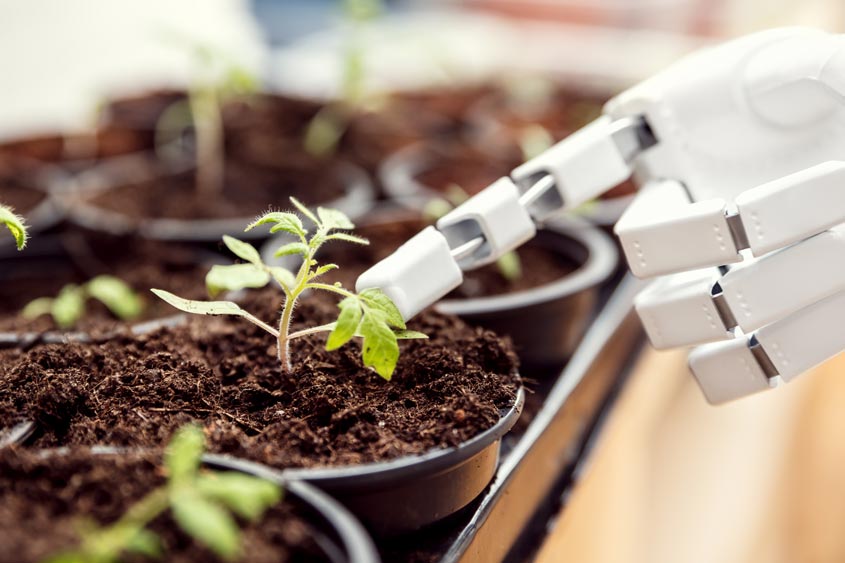
But what exactly is AI? What are the technologies and applications that constitute AI? And what do we know about current research in the field, where it is taking place, who is doing it and what fields it covers?
A new flagship WIPO report, the first in a series looking at technology trends, provides some answers to these questions, drawing on data from patent applications, scientific publications and analysis on trends from AI specialists. This first publication in the WIPO Technology Trends series sets out a scheme for categorizing AI technologies and applications that can be used in further research. It also provides a common information base on AI for policy- and decision-makers in government and business, as well as concerned citizens who are grappling with this new disruptive technology.
As noted by WIPO Director General Francis Gurry in a press release announcing the report’s recent launch in Geneva, “AI’s ramifications for the future of human development are profound. The first step in maximizing the widespread benefit of AI, while addressing ethical, legal and regulatory challenges, is to create a common factual basis for understanding of artificial intelligence. In unveiling the first in our WIPO Technology Trends series, WIPO is pleased to contribute evidence-based projections, thereby informing global policymaking on the future of AI, its governance and the intellectual property (IP) framework that supports it.”
The AI boom
The report shows a massive surge in AI-based innovation. Since AI emerged in the 1960s, innovators and researchers have filed patent applications for nearly 340,000 AI-related inventions and published over 1.6 million scientific publications on AI. AI-related patenting has soared in the past few years, with over half of the identified inventions published since 2013.
The report also identifies a shift from theoretical research to the use of AI technologies in commercial products and services. The boom in scientific publications started around 2001, about 12 years before the surge in patent applications. The decline in the ratio of scientific papers to inventions from 8:1 in 2010 to 3:1 in 2016, is an indication of the shift from theoretical research to practical implementation.
Diving into deep learning
The term AI encompasses many different techniques that are discussed in detail in the report. The most prominent among these is machine learning.
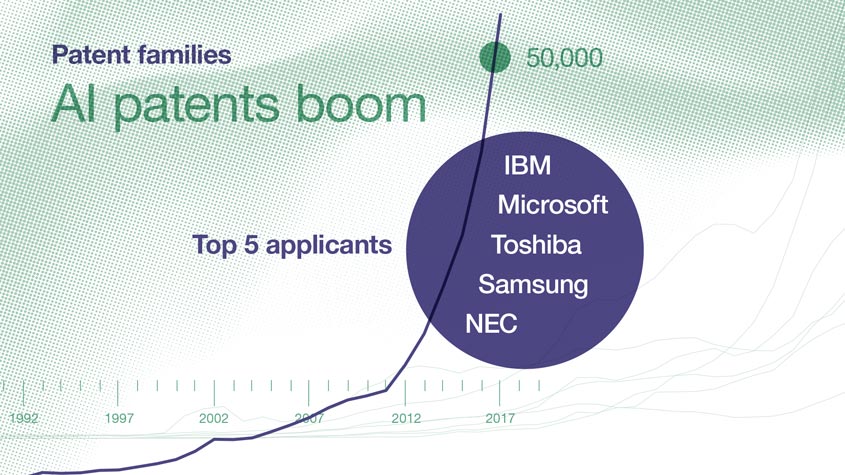
AI will transform every facet of society. It brings tremendous promise to improve our lives and the world we live in, but it will require the creation of an AI ecosystem to ensure long-term, sustainable growth.
Andrew Ng, CEO, Landing AI and deeplearning.ai
Machine learning, such as the techniques being used by ride-sharing services to minimize detours, is a type of AI that focuses on algorithms that allow machines to learn when exposed to new data, and to make predictions or take decisions about that data without being explicitly programmed to perform that task. Machine learning, in particular the neural networks that have revolutionized machine translation, is referenced in more than one-third of all identified AI inventions.
Even more striking is the prominence of deep learning, a machine learning technique that has the potential to revolutionize AI. Deep learning is the fastest-growing technique in the applications studied, with a 20-fold increase in patent applications – from 118 in 2013 to 2,399 in 2016 – equivalent to a 175 percent average annual growth rate. By contrast, in the same period, the number of patent applications for all technologies grew by just 33 percent, or an average annual rate of 10 percent. Deep learning is a form of machine learning that tries to understand the world in terms of a hierarchy of concepts and involves multiple levels of data processing. It is already proving invaluable in popular speech recognition and machine translation tools.
Industry trends
AI-related patents not only disclose AI techniques and applications, they often also refer to a field or industry of application. The WIPO report shows that many sectors and industries are exploring ways to exploit AI commercially. These include banking, entertainment, security, industry, manufacturing, agriculture and networks. Many AI-related technologies can be used across different sectors, as shown by the large number of patents in AI that refer to multiple industries.
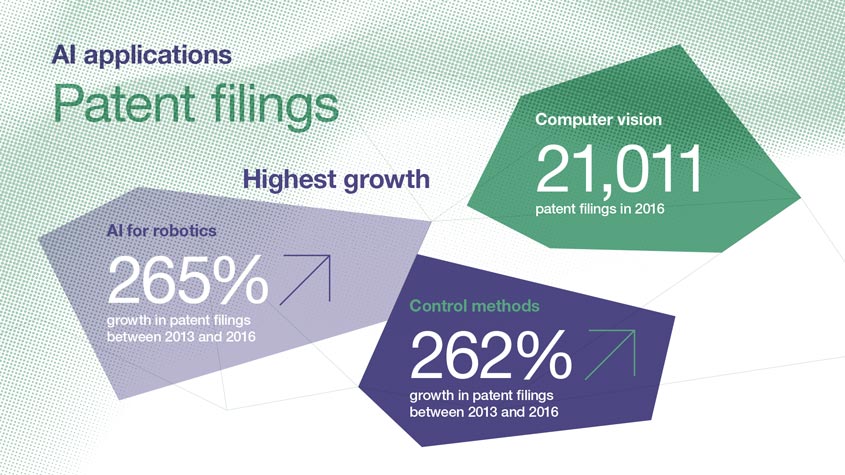
The fields showing the highest growth rates in AI-related patent applications between 2013 and 2016, each growing at least 28 percent a year, are agriculture; banking and finance; computing in government; law; and transportation. Within these industries, rapidly emerging areas are aerospace and avionics which grew by 67 percent on average between 2013 and 2016; followed by smart cities (47 percent); autonomous vehicles (42 percent); customer service (38 percent); and affective computing, which allows machines to recognize human emotions (37 percent).
The leading companies and universities
Japanese and American companies hold the largest AI patent portfolios (see Table 1). While Japanese consumer companies dominate, the two top spots are held by U.S. companies IBM and Microsoft, whose patent portfolios include a wide range of AI applications and techniques.
Patenting activity in the artificial intelligence realm is rising at a rapid pace, meaning we can expect a very significant number of new AI-based products, applications and techniques that will alter our daily lives.
Francis Gurry, Director General, WIPO
But certain companies are strong in different technological fields. For example, Chinese Internet giant Baidu ranks highly for deep learning; Toyota, Bosch and Hyundai are prominent in transportation; and Siemens, Philips and Samsung lead in the life and medical sciences.
Universities and public research organizations are less prominent in the list of top patent filers, accounting for just 167 of the top 500 patent applicants. They are, however, leading in certain areas.
Chinese research organizations make up 17 of the top 20 academic players in AI patenting and 11 of the top 20 in AI-related scientific publications (see Table 2). They are particularly strong in the emerging technique of deep learning. The Chinese Academy of Sciences (CAS) outperforms other similar organizations, with more than 2,500 patent families and more than 20,000 scientific papers published on AI. CAS has the largest deep learning patent portfolio, with 235 patent families. Chinese organizations are consolidating their lead. In the period 2013 to 2016, their AI-related patent filings grew by more than 20 percent per year, matching or beating the growth rates of organizations from other countries.
Organizations from the Republic of Korea also feature prominently among the top academic players, notably the Electronics and Telecommunications Research Institute (ETRI). Nineteen universities or public research organizations from the Republic of Korea feature among the top 500 patent applicants, followed by 20 from the United States and four from Japan. Just four European institutions appear in this list. The highest placed of these is the Fraunhofer Institute (ranked 159th).
Key markets for innovation
The report identifies the most important jurisdictions for AI research, based on the most popular offices for filing AI-related patent applications. The United States Patent and Trademark Office (USPTO) and the China National Intellectual Property Administration (CNIPA) head the list, followed by the Japan Patent Office (JPO). These three offices account for 78 percent of all AI-related patent filings. There is, however, a notable difference between applications filed in Japan and the United States, on the one hand, and those filed in China, on the other hand. While around one third of applications filed in the first two offices are subsequently filed in other countries, just 4 percent of applications first filed in China are subsequently filed elsewhere. This indicates that many Chinese entities are inclined to file patent applications in China alone, perhaps seeing that country as the crucial market for their inventions.
Policy challenges
The data on patents and scientific publications demonstrate the rapid pace of AI innovation. This trend, combined with the broad application of many AI technologies and their potential impact on people’s daily lives, means that AI technologies are raising a number of policy challenges for governments and regulators.
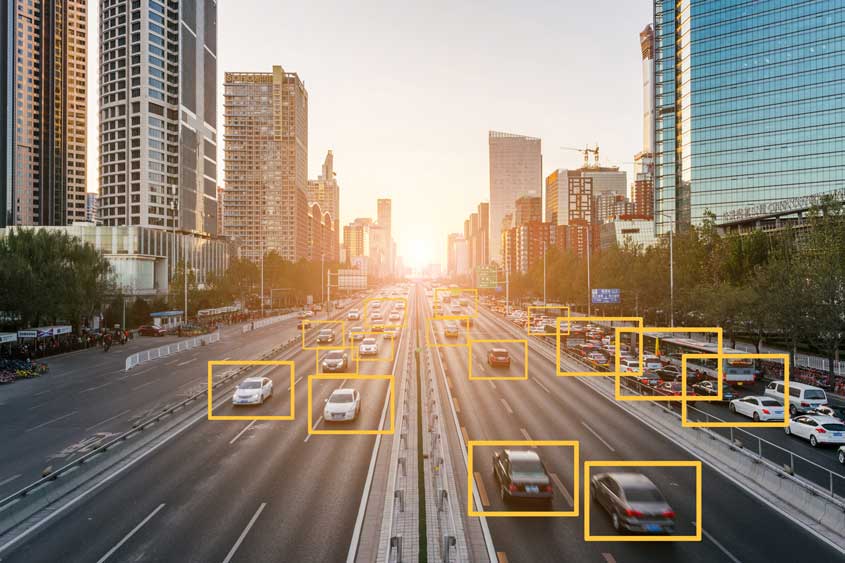
These challenges include the use and protection of personal data, the development of standards and data sharing, how to fund innovation, the regulation of new technologies and even the risk that highly advanced AI – what some have dubbed “superintelligence” – could pose a threat to human existence. Some of these questions are addressed by leading AI experts in the WIPO report, which also provides an overview of some of the policy approaches that governments in different jurisdictions are taking.
One of the contributors, Myriam Côté of Mila (Montreal Institute for Learning Algorithms) in Canada, observes that we are now part of the first major wave in an AI revolution: “Soon, we will see more and more impacts of this technology on our lives. Among them, some should raise our attention: privacy of personal data, fake news generation, employment losses, financial market manipulation, biases in data, diversity issues, etc.” Mila, like other research organizations, is working to increase awareness and understanding of such problems.
In future it will be possible to detect diseases from data collected by wearable sensors, and to suggest optimal treatments to prevent these diseases from developing.
Professor Boi Faltings, Director of the AI Lab at the EPFL
Some experts address the impact AI will have in particular fields, such as digital medicine, and the questions that its use will raise. Boi Faltings of the École Polytechnique Fédérale de Lausanne (EPFL), points out that a smartphone app can detect skin cancer at an early stage from an image taken on a camera: “In future it will be possible to detect diseases from data collected by wearable sensors, and to suggest optimal treatments to prevent these diseases from developing. This will, however, require major data collection efforts and possibly new advances in ensuring data privacy.” Another contributor, Aristotelis Tsirigos of New York University School of Medicine in the United States, discusses a recent study to automate lung cancer diagnosis using AI and imaging data. The accuracy of the AI system was 97 percent – slightly better than the performance of three pathologists who diagnosed the same set of tumors.
In his contribution, investor Kai Fu Lee predicts that the next shift in AI will see technologies being honed to fit actual applications: “We’re at the end of the age of discovery and there’s likely to be an age of implementation,” he says. Baidu’s Haifeng Wang echoes this view: “The latest AI ‘boom’ could be generally summarized as the big leap of functional applications thanks to the explosion in big data, computing power and continued advancing algorithms. Now comes a time when Al applications make a real impact on the economy.”
But this rollout brings challenges for both companies and governments. The World Economic Forum is working with business, government, civil society, intergovernmental organizations and academia to co-create governance mechanisms for AI, including an AI Board Toolkit. The Forum’s Kay Firth-Butterfield argues that soon all companies will need to develop an AI strategy and analyze how it is relevant to their business: “Substantial brand value can be lost if the wrong decisions are made about the use of AI. Therefore, it is important that the various regulatory and other governance mechanisms are thought about now. The fast pace of change in this technology is such that we cannot wait.”
The WIPO Technology Trends (WITT) report on AI and a range of resource materials including a series of expert views on AI and a glossary of terms are available at: www.wipo.int/tech_trends/en/artificial_intelligence/.
Figure 1: AI patent families and scientific publications by earliest publication year.
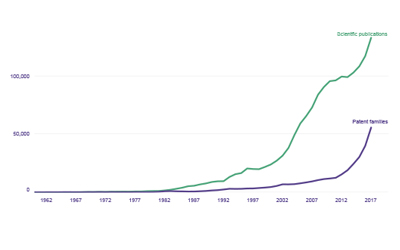
Figure 2: Ratio of scientific publications to patent families by earliest publication year.
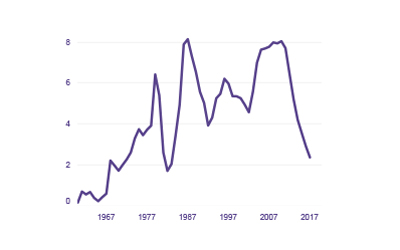
Table 1: AI published patent applications: top 10 companies
| Rank | Company | Number |
|---|---|---|
| 1 | IBM (U.S.) | 8,290 |
| 2 | Microsoft (U.S.) | 5,930 |
| 3 | Toshiba (Japan) | 5,223 |
| 4 | Samsung (Republic of Korea) | 5,102 |
| 5 | NEC (Japan) | 4,406 |
| 6 | Fujitsu (Japan) | 4,303 |
| 7 | Hitachi (Japan) | 4,233 |
| 8 | Panasonic (Japan) | 4,228 |
| 9 | Canon (Japan) | 3,959 |
| 10 | Alphabet (U.S.) | 3,814 |
Table 2: AI patent applications: top 10 universities/public research organizations
| Rank | Organization | Number |
|---|---|---|
| 1 | CAS (People’s Republic of China (PRC)) | 2,652 |
| 2 | ETRI (Republic of Korea) | 1,936 |
| 3 | Xidian University (PRC) | 1,423 |
| 4 | Zhejiang University (PRC) | 1,394 |
| 5 | Industry Academic Cooperation Foundation Korea (Republic of Korea) | 1,281 |
| 6 | Beijing University of Technology (PRC) | 1,190 |
| 7 | Tsinghua University (PRC) | 1,172 |
| 8 | Beihang University (PRC) | 1,026 |
| 9 | Chongqing University (PRC) | 996 |
| 10 | Tianjin University (PRC) | 922 |
The WIPO Magazine is intended to help broaden public understanding of intellectual property and of WIPO’s work, and is not an official document of WIPO. The designations employed and the presentation of material throughout this publication do not imply the expression of any opinion whatsoever on the part of WIPO concerning the legal status of any country, territory or area or of its authorities, or concerning the delimitation of its frontiers or boundaries. This publication is not intended to reflect the views of the Member States or the WIPO Secretariat. The mention of specific companies or products of manufacturers does not imply that they are endorsed or recommended by WIPO in preference to others of a similar nature that are not mentioned.